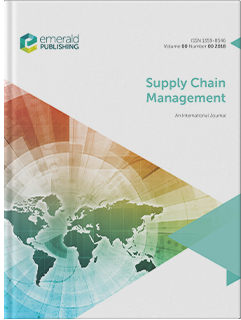消费者保护实践的驱动因素:对运营绩效的影响
IF 8.4
3区 管理学
Q1 BUSINESS
Supply Chain Management: An International Journal
Pub Date : 2023-11-02
DOI:10.1108/scm-06-2023-0284
引用次数: 0
摘要
全球化和外包的增加增加了供应链的复杂性,使公司在产品安全和供应链安全方面面临更大的脆弱性。与此同时,利益相关者向企业施压,要求它们确保产品安全,确保供应链安全。本文旨在借鉴利益相关者理论,探讨供应链的距离和权力特征如何影响消费者保护(CP)实践的采用,从而确保产品安全和供应链安全。设计/方法/方法使用来自加拿大制造公司样本的主要调查数据,本研究考察了供应链特征、CP实践的采用和公司绩效之间的关系。调查结果分析支持使用两个与产品安全相关的实践(消费者教育和产品设计)和三个供应链安全实践(包装,跟踪和真实性)。焦点公司与其供应商之间更大的文化距离与对更安全设计实践的投资呈正相关,而焦点公司与客户之间更大的地理距离与增加的消费者教育显著相关。此外,随着焦点企业相对于其供应商的权力增加,对供应链安全的投资也随之增加。最后,CP实践在多个维度上与改进的操作性能相关。本研究主要关注两个关键利益相关者群体在改善产品安全和供应链安全方面的关键作用:供应商和客户。作者通过识别焦点公司的供应商和客户之间的关键差异,增加了产品安全和供应链安全的理论讨论。其次,该研究告知管理社区投资CP实践的潜在利益。本文章由计算机程序翻译,如有差异,请以英文原文为准。
Drivers of consumer protection practices: implications for operational performance
Purpose Globalization and increased outsourcing have contributed to increased supply chain complexity, exposing firms to greater vulnerability in the areas of product safety and supply chain security. Meanwhile, stakeholders pressure firms to ensure that their products are safe, and their supply chains are secure. Drawing from stakeholder theory, this paper aims to explore how the supply chain characteristics of distance and power affect the adoption of consumer protection (CP) practices, which ensure product safety and supply chain security. Design/methodology/approach Using primary survey data from a sample of Canadian manufacturing firms, this research examines the relationships among supply chain characteristics, adoption of CP practices and firm performance. Findings Analysis supported the use of two practices related to product safety (consumer education and product design) and three practices for supply chain security (packaging, tracking and authenticity). Greater cultural distance between the focal firm and its suppliers was positively associated with investments in safer design practices, while increased geographical distance between the focal firm and the customer was significantly related to increased consumer education. Moreover, as power of a focal firm relative to its suppliers increased, so too did investments in supply chain security. Finally, CP practices were related to improved operational performance along multiple dimensions. Originality/value This research focuses on the critical role of two key stakeholder groups in improving product safety and supply chain security: suppliers and customers. The authors add to the theoretical discussion of product safety and supply chain security by identifying critical differences between suppliers and customers for the focal firm. Second, the research informs the managerial community of the potential benefits of investments in CP practices.
求助全文
通过发布文献求助,成功后即可免费获取论文全文。
去求助
来源期刊
CiteScore
16.70
自引率
5.70%
发文量
27
期刊介绍:
Supply Chain Management (SCM) is a journal that places great emphasis on research findings with international relevance and global impact, benefitting both theory and practice. To be considered for publication, research papers and case studies submitted to SCM must contribute to extending supply chain knowledge beyond a dyadic perspective.
The journal focuses specifically on empirical research and does not accept submissions related to modelling or simulation. This is because the challenges posed by globalization and rapidly evolving technology trends have a direct impact on supply chain design and management. Therefore, it is essential for contemporary supply chain practices to be responsive, proactive, integrated, and driven by information when managing the various components of the supply chain.

 求助内容:
求助内容: 应助结果提醒方式:
应助结果提醒方式:


